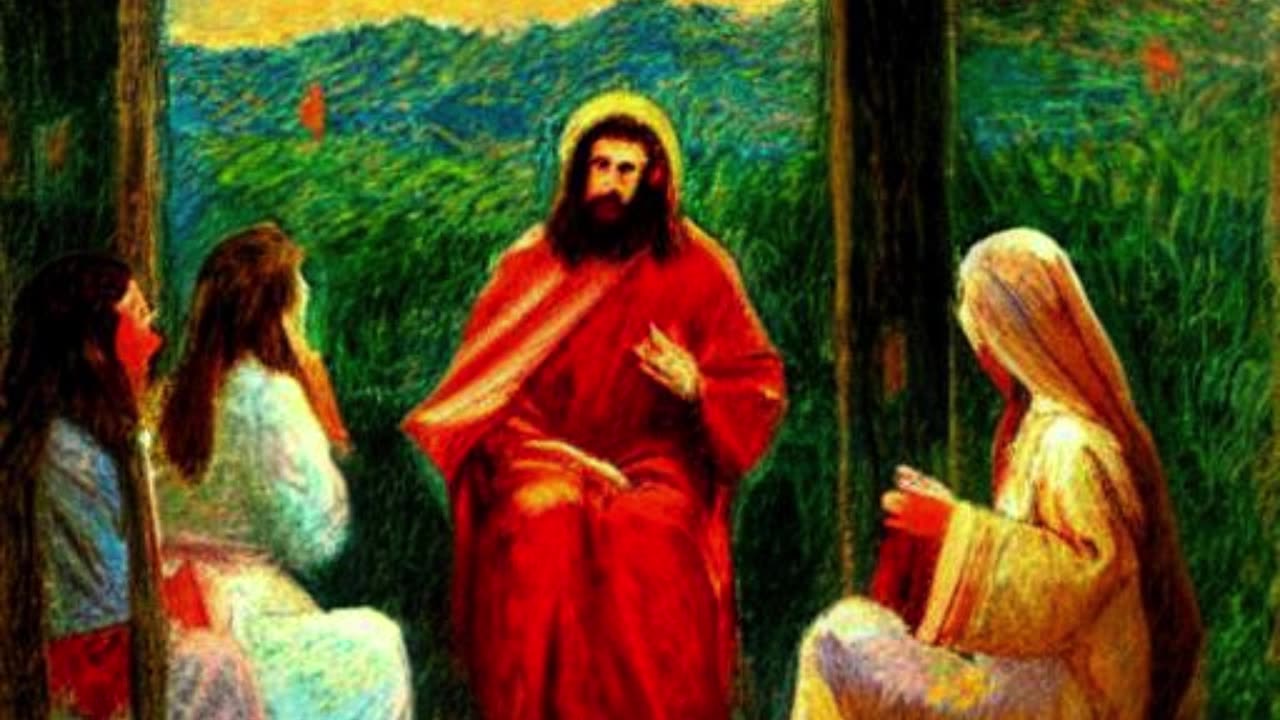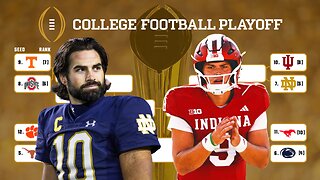Premium Only Content

Warren Jeffs - Jesus Apostles & His Wives
https://en.wikipedia.org/wiki/Warren_Jeffs
Audio Recordings of The FLDS Prophet Warren Jeffs, speaks on the topic of Jesus and his Wives.
Not to be confused with Disciple (Christianity).
"Twelve Apostles" redirects here. For other uses, see Twelve Apostles (disambiguation).
For apostles in general, see Apostle. For other uses, see Apostle (disambiguation).
The Last Supper, a late 1490s mural painting by Leonardo da Vinci, is a depiction of the last supper of Jesus and his Twelve Apostles on the eve of his crucifixion. Santa Maria delle Grazie, Milan
Jesus and his Twelve Apostles, fresco with the Chi-Rho symbol ☧, Catacombs of Domitilla, Rome
Part of a series on
Christianity
Principal symbol of Christianity
JesusChrist
BibleFoundations
Theology
HistoryTradition
Denominations(full list)
Related topics
GlossaryIndexOutline
Christian cross Christianity portal
vte
In Christian theology and ecclesiology, the apostles, particularly the Twelve Apostles (also known as the Twelve Disciples or simply the Twelve), were the primary disciples of Jesus according to the New Testament. During the life and ministry of Jesus in the 1st century AD, the apostles were his closest followers and became the primary teachers of the gospel message of Jesus.[1] There is also an Eastern Christian tradition derived from the Gospel of Luke that there were seventy apostles during the time of Jesus' ministry.[2]
The commissioning of the Twelve Apostles during the ministry of Jesus is described in the Synoptic Gospels. After his resurrection, Jesus sent eleven of them (as Judas Iscariot by then had died) by the Great Commission to spread his teachings to all nations.
In the Pauline epistles, Paul, although not one of the original twelve, described himself as an apostle,[3] saying he was called by the resurrected Jesus himself during his road to Damascus event. He later describes himself as "an apostle to the Gentiles".[4] The period and associated events in timeline of early Christianity during the lifetimes of the twelve apostles is called the Apostolic Age.[5]
Names of the 12 disciples of Jesus Christ
Simon (also known as Peter)
Andrew (Peter's brother)
Jacob/James (son of Zebedee and John's brother)
John (son of Zebedee and Jacob's brother)
Philip (friend of Bartholomew/Nathanael)
Bartholomew (friend of Philip, the Gospel of John refers him as Nathanael)
Matthew (the publican, or Levi)
Thomas (also called Didymus (twin), the translation of his Hebrew name in the Greek Language)[6]
Jacob/James (son of Alphaeus to distinguish him from Jacob/James (son of Zebedee))
Simon (the Canaanite)
Judas Iscariot (son of Simon Iscariot;[7] the characterization Iscariot is used to distinguish him from Jude, also known as Judas of Jacob)
Jude (also Thaddaeus (or Lebbaeus); called "Judas the Zealot" in some translations[8])
Etymology
Further information: Apostle § Terminology
The Synaxis of the Twelve Apostles. Russian, 14th century, Moscow Museum
The term apostle comes from the Greek apóstolos (ἀπόστολος) – formed from the prefix apó- (ἀπό-, 'from') and root stéllō (στέλλω, 'I send, I depart') – originally meaning 'messenger, envoy'. It has, however, a stronger sense than the word messenger, and is closer to a 'delegate'.[9]
Biblical narratives
Mark 6:7–13 states that Jesus initially sent out these twelve in pairs (cf. Mt 10:5–42, Lk 9:1–6) to towns in Galilee. The text states that their initial instructions were to heal the sick and drive out demons.[9] They are also instructed to "take nothing for their journey, except a staff only: no bread, no wallet, no money in their purse, but to wear sandals, and not put on two tunics," and that if any town rejects them they ought to shake the dust off their feet as they leave, a gesture which some scholars think was meant as a contemptuous threat.[10]
Later in the Gospel narratives, the Twelve Apostles are described as having been commissioned to preach the Gospel to "all the nations,"[11] regardless of whether Jew or Gentile.[12] Paul emphasized the important role of the apostles in the church of God when he said that the household of God is "built upon the foundation of apostles and prophets, Christ Jesus himself being the cornerstone."[13]
Calling by Jesus
Vocation of the Apostles, a fresco in the Sistine Chapel by Domenico Ghirlandaio, 1481–82
James Tissot, The Exhortation to the Apostles
All four canonical Gospels record the circumstances in which some of the disciples were recruited.[14][15][16][17] According to the Gospel of John, Andrew, who was the disciple of John the Baptist, and another unnamed disciple of John the Baptist, traditionally believed to be John, upon hearing the Baptist point out Jesus as the "Lamb of God", followed Jesus and spent the day with him, thus becoming the first two disciples called by Jesus. For this reason the Eastern Orthodox Church honours Andrew with the name Protokletos, which means "the first called".[18]
Despite Jesus only briefly requesting that they join him, they are all described as immediately consenting and abandoning their nets to do so. The immediacy of their consent has been viewed as an example of divine power, although this is not stated in the text. Another explanation is that some of the disciples may have heard of Jesus beforehand, as implied by the Gospel of John, which states that Andrew was a disciple of John the Baptist, and that he and his brother started following Jesus as soon as Jesus had been baptized.[19]
Adriaen van de Venne's Fishing for Souls, oil on panel, 1614
Matthew describes Jesus meeting James and John, also fishermen and brothers, very shortly after recruiting Simon and Andrew. Matthew and Mark identify James and John as sons of Zebedee. Luke adds to Matthew and Mark that James and John worked as a team with Simon and Andrew. Matthew states that at the time of the encounter, James and John were repairing their nets, but readily joined Jesus without hesitation.[20]
This parallels the accounts of Mark and Luke, but Matthew implies that the men have also abandoned their father (since he is present in the boat they abandon behind them), and Carter feels this should be interpreted to mean that Matthew's view of Jesus is one of a figure rejecting the traditional patriarchal structure of society, where the father had command over his children; most scholars, however, just interpret it to mean that Matthew intended these two to be seen as even more devoted than the other pair, or that Jesus expected the imminent coming of the kingdom.[21]
The Synoptic Gospels go on to describe that later in Jesus' ministry he noticed a tax collector in his booth. The tax collector, called Matthew in Matthew 9:9, and Levi in Mark 2:14 and Luke 5:27, is asked by Jesus to become one of his disciples. Matthew/Levi is stated to have accepted and then invited Jesus for a meal with his friends. Tax collectors were seen as villains in Jewish society, and the Pharisees are described as asking Jesus why he is having a meal with such disreputable people. The reply Jesus gave is now well known: "it is not the healthy who need a doctor, but the sick. I have not come to call the righteous, but sinners to repentance."[22]
Commissioning of the Twelve Apostles
The commissioning of the Twelve Apostles is an episode in the ministry of Jesus that appears in the three Synoptic Gospels. It relates the initial selection of the Twelve Apostles among the disciples of Jesus.[23][24]
In the Gospel of Matthew, this event takes place shortly before the miracle of the man with a withered hand. In the gospels of Mark and of Luke, it appears shortly after that miracle.[25]
Then Jesus summoned his twelve disciples and gave them authority over unclean spirits, to cast them out, and to cure every disease and every sickness. These are the names of the twelve apostles: first, Simon, also known as Peter, and his brother Andrew; James son of Zebedee, and his brother John; Philip and Bartholomew; Thomas and Matthew the tax collector; James son of Alphaeus, and Thaddaeus; Simon the Cananaean, and Judas Iscariot, the one who betrayed him.
— Matthew 10:1–4[26]
He went up the mountain and called to him those whom he wanted, and they came to him. And he appointed twelve, whom he also named apostles, to be with him, and to be sent out to proclaim the message, and to have authority to cast out demons. So he appointed the twelve:[b] Simon (to whom he gave the name Peter); James son of Zebedee and John the brother of James (to whom he gave the name Boanerges, that is, Sons of Thunder); and Andrew, and Philip, and Bartholomew, and Matthew, and Thomas, and James son of Alphaeus, and Thaddaeus, and Simon the Cananaean, and Judas Iscariot, who betrayed him.
— Mark 3:13–19[27]
One of those days Jesus went out to a mountainside to pray, and spent the night praying to God. When morning came, he called his disciples to him and chose twelve of them, whom he also designated apostles: Simon (whom he named Peter), his brother Andrew, James, John, Philip, Bartholomew, Matthew, Thomas, James son of Alphaeus, Simon who was called the Zealot, Judas son of James, and Judas Iscariot, who became a traitor.
— Luke 6:12–16[28]
Lists of the Twelve Apostles in the New Testament
Monument of Jesus and the Twelve Apostles in Domus Galilaeae, Israel
Each of the four listings of apostles in the New Testament[29] indicate that all the apostles were men. The canonical gospels and the book of Acts give varying names of the Twelve Apostles. The list in the Gospel of Luke differs from Matthew and Mark on one point. It lists "Judas, the son of James" instead of "Thaddaeus".[a] All listings appear in three groupings, always with the same four apostles in each group. Each group is always led by the same apostle, although the order of the remaining three names within the group varies. Thus, Peter is always listed first, Philip is always listed fifth, and James, son of Alphaeus is always listed ninth. Judas Iscariot is always listed last.
Unlike the Synoptic Gospels, the Gospel of John does not offer a formal list of apostles. Although it refers to "the Twelve",[30] the gospel does not present any elaboration of who these twelve actually were, and the author of the Gospel of John does not mention them all by name. There is also no separation of the terms "apostles" and "disciples" in John.
According to the New Testament there were only two pairs of brothers among the Twelve Apostles: Peter and Andrew, the sons of Jonah, as well as James and John, the sons of Zebedee. Since the father of both James, son of Alphaeus and Matthew is named Alphaeus, according to the tradition of the Eastern Orthodox Church the two were brothers as well.[31][32] According to the tradition of the Catholic Church based on the writing of the Apostolic Father Papias of Hierapolis the apostles James, son of Alphaeus, and Thaddaeus were brothers and sons of Alphaeus (named also Clopas) and his wife Mary of Clopas who was the sister of the mother of Jesus.[33] The Golden Legend, compiled by Jacobus de Voragine in the 13th century, adds to the two apostles also Simon the Zealot.[34][35]
Gospel of Matthew[36] Gospel of Mark[27] Gospel of Luke[37] Gospel of John Acts of the Apostles[38]
Simon ("also known as Peter") Simon ("to whom he gave the name Peter") Simon ("whom he named Peter") Simon Peter[7] / Cephas "which is translated Peter"[39] Peter
Andrew ("his [Peter's] brother") Andrew Andrew ("his [Peter's] brother") Andrew ("Simon Peter's brother") Andrew
James ("son of Zebedee") James ("son of Zebedee") / one of the "Boanerges" James one of the "sons of Zebedee" James
John ("his [James's] brother") John ("brother of James") / one of the "Boanerges" John one of the "sons of Zebedee" / the "disciple whom Jesus loved"[b] John
Philip Philip Philip Philip Philip
Bartholomew Bartholomew Bartholomew Nathanael Bartholomew
Thomas Thomas Thomas Thomas ("also called Didymus")[40] Thomas
Matthew ("the publican") Matthew / Levi Matthew / Levi not mentioned Matthew
James ("son of Alphaeus") James ("son of Alphaeus") James ("son of Alphaeus") not mentioned James ("son of Alphaeus")
Thaddaeus (or "Lebbaeus"); called "Judas the Zealot" in some translations[8] Thaddaeus Judas ("son of James," referred to as brother in some translations) Judas ("not Iscariot")[41] Judas ("son of James," referred to as brother in some translations)
Simon ("the Canaanite") Simon ("the Cananaean") Simon ("who was called the Zealot") not mentioned Simon ("the Zealot")
Judas Iscariot Judas Iscariot Judas Iscariot Judas ("son of Simon Iscariot")[7] (Judas replaced by Matthias)
Inner circle among the Twelve Apostles
Peter, James son of Zebedee, and James's brother John formed an informal triumvirate among the Twelve Apostles in the Gospels. Jesus invited them to be the only apostles present on three notable occasions during his public ministry: the Raising of Jairus' daughter,[42] the Transfiguration of Jesus,[43] and the Agony in the Garden of Gethsemane.[44]
At the time of the Early Christian Church as a leading trio among the apostles were recognized Peter, John and James, brother of Jesus, known collectively as the three Pillars of the Church.[45][46] According to the tradition of the Catholic Church based on the writing of Jerome this James is identified with the apostle James, son of Alphaeus.[47][48]
Two of the leading triumvirate, Peter and John, were additionally sent by Jesus into the city to make preparation for the final Passover meal (the Last Supper),[49] and were also the only two sent by the collective apostles to visit the newly converted believers in Samaria.[50] If John is to be identified with the disciple whom Jesus loved, then it was also only Peter and John who followed behind Jesus after his capture in the Garden of Gethsemane,[51] and who ran to the empty tomb after Mary Magdalene bore witness to the resurrection of Jesus.[52][53]
Replacement of Judas Iscariot
Main article: Matthias the Apostle
After Judas betrayed Jesus (and then in guilt committed suicide before Christ's resurrection, one Gospel recounts), the apostles numbered eleven. The group is referred to as "the eleven" in Mark 16:14 (part of the "longer ending" of Mark) and in Luke 24:9,33. In Acts 1:26 they are "the eleven apostles", in Matthew 28:16 they are "the eleven disciples". When Jesus had been taken up from them, in preparation for the coming of the Holy Spirit that he had promised them, Peter advised the brethren:
Judas, who was guide to those who took Jesus... For he was numbered with us, and received his portion in this ministry... For it is written in the book of Psalms, "Let his habitation be made desolate, Let no one dwell therein", and, "Let another take his office"... So one of the men who have accompanied us during all the time that the Lord Jesus went in and out among us, beginning from the baptism of John until the day he was taken up from us, must become with us a witness to his resurrection.
— Acts 1:15–22
So, between the Ascension of Jesus and the day of Pentecost, the remaining apostles elected a twelfth apostle by casting lots, a traditional Israelite way to determine the will of God (see Proverbs 16:33). The lot fell upon Matthias.
Paul the Apostle, in his First Epistle to the Corinthians, appears to give the first historical reference to the Twelve Apostles: "For I delivered to you as of first importance what I also received: that Christ died for our sins in accordance with the Scriptures, that he was buried, that he was raised on the third day in accordance with the Scriptures, and that he appeared to Cephas, then to the twelve" (1 Cor 15:3–5).
Other apostles mentioned in the New Testament
Person called apostle Where in Scripture Notes
Barnabas Acts 14:14[54] —
James the Just, the brother of Jesus 1 Corinthians 15:7, Galatians 1:19 —
Andronicus and Junia Romans 16:7[55] Paul states that Andronicus and Junia were "of note among the apostles." This has been traditionally interpreted in one of two ways:
That Andronicus and Junia were "of note among the apostles," that is, distinguished apostles.[56]
That Andronicus and Junia were "well known among the apostles" meaning "well known to the apostles"
If the first view is correct then Paul may be referring to a female apostle[57][58] – the Greek name (Iounian) is in the accusative and could be either Junia (a woman) or Junias (a man).[59] Later manuscripts add accents to make it unambiguously Junias; however, while "Junia" was a common name, "Junias" was not,[58] and both options are favored by different Bible translations.
In the second view, it is believed that Paul is simply making mention of the outstanding character of these two people which was acknowledged by the apostles.
Historically it has been virtually impossible to tell which of the two views were correct. The second view, in recent years, has been defended from a scholarly perspective by Daniel Wallace and Michael Burer.[60]
The seventy disciples
Main article: Seventy disciples
The "seventy disciples" or "seventy-two disciples" (known in the Eastern Christian traditions as the "Seventy Apostles") were early emissaries of Jesus mentioned in the Gospel of Luke.[61] According to Luke, the only gospel in which they appear, Jesus appointed them and sent them out in pairs on a specific mission which is detailed in the text.
In Western Christianity, they are usually referred to as disciples,[62] whereas in Eastern Christianity they are usually referred to as apostles.[63] Using the original Greek words, both titles are descriptive, as an apostle is one sent on a mission (the Greek uses the verb form: apesteilen) whereas a disciple is a student, but the two traditions differ on the scope of the words apostle and disciple.
Paul, Apostle of the Gentiles
Part of a series of articles on
Paul in the Bible
Pauline literature (Authorship)
Related literature
See also
vte
Main article: Paul the Apostle
Although not one of the apostles commissioned during the life of Jesus, Paul, a Jew also named Saul,[64] claimed a special commission from the post-ascension Jesus as "the apostle of the Gentiles",[65] to spread the gospel message after his conversion. In his writings, the epistles to Christian churches throughout the Levant, Paul did not restrict the term "apostle" to the twelve, and often refers to his mentor Barnabas as an apostle.[5]
In his writings, Paul, although not one of the original twelve, described himself as an apostle.[3] He was called by the resurrected Jesus himself during his Road to Damascus event. With Barnabas, he was allotted the role of apostle in the church.[66]
Since Paul claimed to have received a gospel not from teachings of the Twelve Apostles but solely and directly through personal revelations from the post-ascension Jesus,[67] after Jesus's death and resurrection (rather than before like the twelve), Paul was often obliged to defend his apostolic authority (1 Cor. 9:1 "Am I not an apostle?") and proclaim that he had seen and was anointed by Jesus while on the road to Damascus.
Paul considered himself perhaps inferior to the other apostles because he had originally persecuted Christ's followers[68] while thinking he was not in the least inferior to those "super-apostles" and not lacking in "knowledge".[69]
Paul referred to himself as the apostle of the Gentiles.[70] According to Paul's account in his Epistle to the Galatians, James, Peter and John in Jerusalem accepted the "grace" given to Paul and agreed that Paul and Barnabas should go to the Gentiles (specifically those not circumcised) and the three apostles who "seemed to be pillars" to the circumcised.[71] Despite the Little Commission of Matthew 10, the Twelve Apostles did not limit their mission to solely Jews as Cornelius the Centurion is widely considered the first Gentile convert and he was converted by Peter, and the Great Commission of the resurrected Jesus is specifically to "all nations".
As the Catholic Encyclopedia states, "It is at once evident that in a Christian sense, everyone who had received a mission from God, or Christ, to man could be called 'Apostle'"; thus extending the original sense beyond the twelve.[9]
Deaths
Relics of the apostles in 2017, while they were in Utah during the Relic Tour[72]
Of the Twelve Apostles to hold the title after Matthias' selection, Christian tradition has generally passed down that all of the Twelve Apostles except John were martyred. It is traditionally believed that John survived all of them, living to old age and dying of natural causes at Ephesus sometime after AD 98, during the reign of Trajan.[73][74] However, only the death of his brother James who became the first Apostle to die in c. AD 44 is described in the New Testament.[75] (Acts 12:1–2)
Matthew 27:5 says that Judas Iscariot threw the silver he received for betraying Jesus down in the Temple, then went and hanged himself. Acts 1:18 says that he purchased a field, then "falling headlong he burst open in the middle and all his bowels gushed out".
According to the 18th-century historian Edward Gibbon, early Christians (second half of the second century and first half of the third century) believed that only Peter, Paul, and James, son of Zebedee, were martyred.[76] The remainder, or even all, of the claims of martyred apostles do not rely upon historical or biblical evidence, but only on late legends.[77][78]
Relics and burial sites
Relics of the apostles are claimed by various churches, many in Europe.
Andrew: buried in Cathedral of Saint Andrew, Patras, Greece[79]
Bartholomew: buried in the Basilica of Benevento, Italy, or Basilica of St. Bartholomew on the Island, Rome, Italy[80]
James the Great: buried in Santiago de Compostela Cathedral in Santiago de Compostela, Galicia, Spain
James, son of Alphaeus: buried in the Cathedral of St. James in Jerusalem or the Church of the Holy Apostles in Rome.[81][82]
John: no relics. The opening of his tomb (in the Basilica of St. John, Ephesus) during Constantine the Great's reign yielded no bones, giving rise to the belief that his body was assumed into heaven.[83]
Judas Iscariot: buried at Akeldama near Jerusalem (per the Gospel of Matthew and Acts of the Apostles).
Jude Thaddeus: buried in St. Peter's Basilica under the St. Joseph altar with St. Simon the Zealot; two bones (relics) located at National Shrine of St. Jude in Chicago; other relics claimed by Reims Cathedral and Toulouse Cathedral.[84][85][86]
Matthew: buried in the Salerno Cathedral, Italy.[87]
Matthias: buried in the St. Matthias' Abbey in Trier, Germany.[88]
Paul: relics located in the Basilica of Saint Paul Outside the Walls in Rome; the skull located in the Archbasilica of Saint John Lateran, alongside the skull of St. Peter.[89]
Peter: buried in St. Peter's Basilica in Vatican City, Rome, Italy; the skull located in the Archbasilica of Saint John Lateran, alongside the skull of St. Paul.[89]
Philip: buried in the Church of the Holy Apostles in Rome or possibly Hierapolis, modern Turkey.[90][82]
Simon the Zealot: buried in St. Peter's Basilica in Rome under the St. Joseph altar with St. Jude.[91]
Thomas: buried in the San Thome Basilica in Chennai, India or in the Basilica of St. Thomas the Apostle in Ortona, Italy.[92][93]
Legacy
By the 2nd century AD, association with the apostles was esteemed as an evidence of authority. Churches that are believed to have been founded by one of the apostles are known as apostolic sees.[5]
Paul's epistles were accepted as scripture, and two of the four canonical gospels were associated with apostles, as were other New Testament works. Various Christian texts, such as the Didache and the Apostolic Constitutions, were attributed to the apostles.[5] The Apostles' Creed, popular in the West, was alleged to have been composed by the apostles themselves.
Bishops traced their lines of succession back to individual apostles, who were said to have dispersed from Jerusalem and established churches across great territories. Christian bishops have traditionally claimed authority deriving, by apostolic succession, from the Twelve Apostles.[5]
Early Church Fathers who came to be associated with apostles – such as Pope Clement I with St. Peter – are referred to as the Apostolic Fathers
Original Source: https://rumble.com/v28g0i7-flds-beliefs-jesuss-his-wives-and-the-12-apostles.html
-
 53:31
53:31
Dave Portnoy
3 hours agoThe Unnamed Show With Dave Portnoy, Kirk Minihane, Ryan Whitney - Episode 40
9.11K1 -
 2:45:29
2:45:29
Matt Kohrs
13 hours agoMarket Crash, Breaking Inflation News & Payday Friday || The MK Show
26.8K4 -
 LIVE
LIVE
LFA TV
14 hours agoWHAT IS HAPPENING IN DC?? | LIVE FROM AMERICA 12.20.24 11am EST
4,576 watching -
 LIVE
LIVE
Caleb Hammer
1 hour agoDelusional Lady Destroys Life To Hurt Her Ex | Financial Audit
136 watching -
 49:01
49:01
BonginoReport
4 hours agoThe Final Countdown to Shutdown (Ep.109) - 12/20/2024
55.3K164 -
 LIVE
LIVE
Wendy Bell Radio
6 hours agoCongress Plays Shutdown Chicken
10,745 watching -
 1:55:07
1:55:07
Jeff Ahern
3 hours ago $0.85 earnedNews of the day with Jeff Ahern ( Here comes the holiday weekend!)
8.32K -
 1:18:33
1:18:33
Game On!
15 hours ago $8.77 earnedCollege Football Playoff Round 1 BEST BETS! | Indiana vs Notre Dame Preview
63.2K4 -
 42:08
42:08
PMG
10 hours ago $3.80 earned"Hannah Faulkner and James Staake | PAYPAL WITHHELD 100K FOR POLITICAL VIEWS?!"
24.8K3 -
 14:15
14:15
This Bahamian Gyal
21 hours agoDC server REFUSED to serve Donald TRUMP, then THIS happened . . .
44.4K32